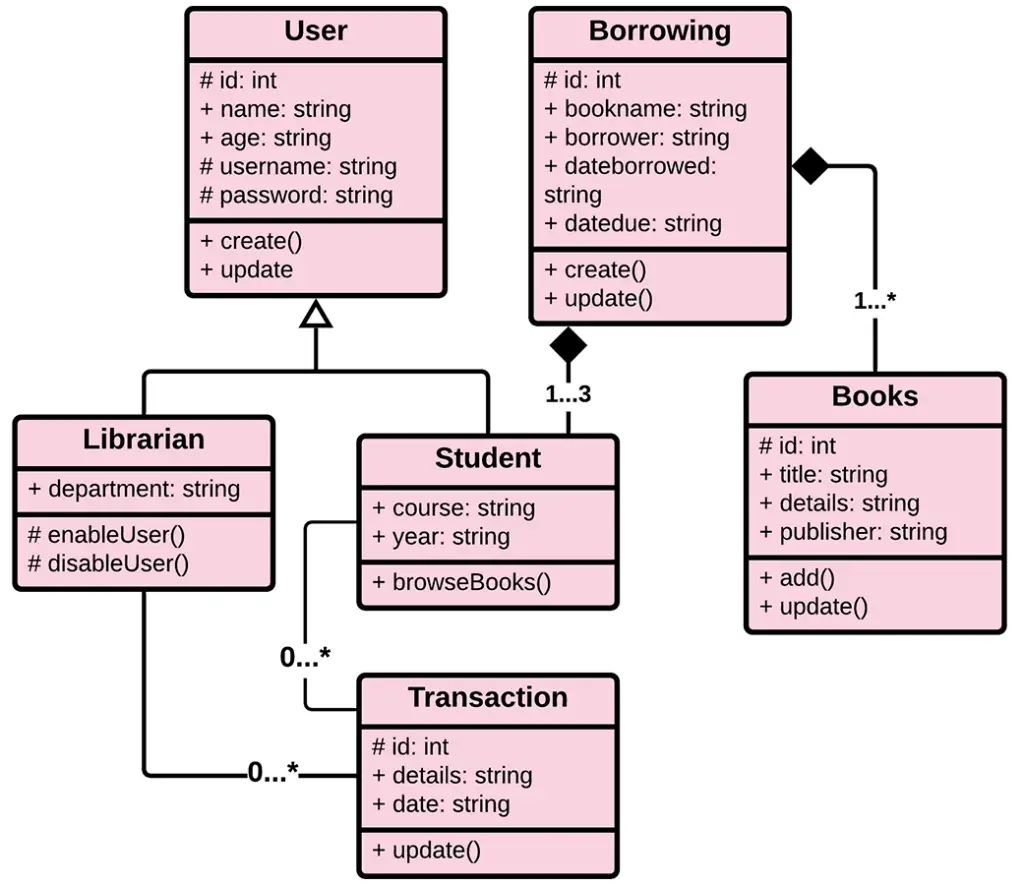A Library Management System Class Diagram is a form of structural (UML) diagram that depicts the library’s management structure. This is designed by displaying the system’s classes, attributes, methods, and relationships between classes.
Class diagrams reveal the class structure blueprint of the Library Management System. It is used to model the items that make up the system and depict their relationships. This is to define the function of an object and the operation it provides.
Check out our Related and Recommended Articles for more Learnings and Information.
- Library Management System UML Diagrams
- Activity Diagram for Library Management System
- Component Diagram of Library Management System
- Use Case Diagram for Library Management System
- Deployment Diagram for Library Management System
- Library Management System Sequence Diagram
- College Library Management System ER Diagram
Library Management System Class Diagram: Details
The table shows the name and details of the library management system class diagram. It has complete information on project components and diagramming tools.
| Name: | Library Management System Class Diagram |
| Abstract: | The Library Management System Class Diagram represents the structure of the project in terms of its classes. It contains the important details on the data characteristics present in the project. |
| UML Diagram: | Class Diagram |
| Users: | School Admin, Book Borrowers, and Librarian. |
| Tools Used: | Diagram tools that provide class diagram symbols. |
| Designer: | ITSourceCode.com |
Importance of Library Management System Class Diagram
The class diagram for library management system in UML is that it helps in visualizing the classes that make up the system. It displays the classes’ connections and reports their characteristics, operations, and methods used.
UML Class Diagram for Library Management System
The UML Class Diagram for Library Management System in UML describes an entity. A group of objects with similar structure and characteristics. A box with three rows is used to represent them.
The class diagram is presented in a rectangle with three partitions. The upper part is for the name of the class. The middle is for its attributes, and the bottom is for the methods. These partitions will clearly emphasize the details of the classes.
Library Management System Class Diagram: Benefits
Their Benefits are as follows:
- It aids in the better and more accurate illustration of data models.
- It explains a more straightforward and clear understanding of the overall system or process’ overview and schematics.
- It provides a sense of direction.
- It gives a lot of information on the structure of your systems.
- Summarize the system’s static perspective.
- It enumerates how the parts of a static view work together.
- defines the functions that the system does, and object-oriented programming languages are used to create software applications.
Class Diagram for Library Management System with Explanation
The simple class diagram for library management system is given with an explanation to expound on its ideas. This Class Diagram gives you the exact details about the class characteristics and methods. It also clarifies the connections between classes in the system.

The classes identified for the Library Management System were the users (librarians and students or borrowers), books, borrowing, and transactions.
Steps in Creating Class Diagram for Library Management System
Time needed: 5 minutes
Steps in creating a Class Diagram for the Library Management System are elaborated here.
- Step 1: Familiarize Class Diagram Components
Class Diagram Components are used to create Class Diagrams, which were presented here. They should be familiarized with them before you build the Class Diagram.
Class Name: The name of the class appears in the upper portion. Whether you’re talking about the classifier or an object, this portion is always essential.
Class Attributes: The class’s attributes are found in the middle portion. Use this section to describe the class’s characteristics. When specifying a specific instance of a class, this is only required.
Class operations are included in the bottom part (methods). Each action has its own line when displayed in a list format. The operations are the methods by which a class interacts with data.
Class Connections: Depending on the access modifier, each class has a different level of access (visibility). The following are the access levels and the symbols that correlate with them:
• Public (+)
• Private (-)
• Protected (#)
• Package (~)
• Derived (/)
• Static (underlined)
Each of these class diagram components shows the overall class structure. Emphasizing the system’s structure would be much easier by using these class diagram symbols. - Step 2: Determine the targeted users
After the symbol familiarization, you’ll need to determine your target users. Your targeted users will be the ones to use your project.
Your project is a library management system for a school. Then your users would be the staff, admin, and students.
You may ask them about the common activities that they do when doing tasks that require recognizing faces. This information will help you proceed with the next step. - Step 3: Analyze the activities included
Analyzation is very important in creating a class diagram. It will help you understand the meaning of the diagram and avoid making unwanted errors.
The gathered information from the targeted users is very useful in creating a class diagram. You just need to evaluate this data and pick the useful classes. Then you’re ready for the next step. - Step 4: Plot the Class Diagram
To plot the class diagram, you will need the class name, its attributes, methods, and their access (visibility). You will base the diagram on the evaluated information to have the exact class diagram.
To plot your class diagram, you need to first place the classes and their characteristics.
Then set the visibility of the class’s attributes. You will declare their visibility in the project to know their function.
Finally, write the connections or relations of a class to the other classes. to make sure they are working to produce the desired outcome.
Conclusion:
You need to know the diagrams used to design and develop the Library Management System. This is due to the fact that without it, it is impossible to create a fully functional system.
But if you create this class diagram, you will know the possible classes and scenarios. The system should process and perform. Not only that, but you will identify the processes that are required and connect them to the other UML Diagrams.
Inquiries
If you have inquiries or suggestions about the Library Management System Class Diagram, just leave us your comments below. We would be glad to hear your concerns and suggestions and be part of your learning.
Keep us updated and Good day!

